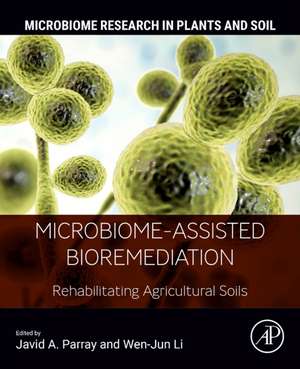Microbiome-Assisted Bioremediation: Rehabilitating Agricultural Soils: Microbiome Research in Plants and Soil
Editat de Javid A. Parray, Wen-Jun Lien Limba Engleză Paperback – 24 ian 2024
Microbial remediation has appeared as a promising approach to lessen the heavy metal concentration in the environment due to their sequestration and transforming ability of xenobiotic compounds. Microbial bioremediation is an efficient, economical, and environmentally-friendly procedure that reduces the cost of the cleanup process associated with heavy and toxic metal contamination.
- Emphasizes microbiome-assisted biodegradation of toxic substances in soil
- Includes complete descriptions of the most recent and advanced techniques
- Addresses the use of GMOs, nanotechnologies and in silico studies
- Outlines developments in the microbial degradation of synthetic plastics in soil and the biodegradation enzymes
Preț: 967.27 lei
Preț vechi: 1261.69 lei
-23% Nou
Puncte Express: 1451
Preț estimativ în valută:
185.15€ • 201.18$ • 155.62£
185.15€ • 201.18$ • 155.62£
Carte tipărită la comandă
Livrare economică 14-28 aprilie
Livrare express 14-20 martie pentru 120.29 lei
Preluare comenzi: 021 569.72.76
Specificații
ISBN-13: 9780443219115
ISBN-10: 0443219117
Pagini: 518
Dimensiuni: 191 x 235 x 27 mm
Greutate: 1.07 kg
Editura: ELSEVIER SCIENCE
Seria Microbiome Research in Plants and Soil
ISBN-10: 0443219117
Pagini: 518
Dimensiuni: 191 x 235 x 27 mm
Greutate: 1.07 kg
Editura: ELSEVIER SCIENCE
Seria Microbiome Research in Plants and Soil
Cuprins
1. Bioremediation: An emerging Technology for remediation of pesticides
2. Bioremediation techniques- classification, principles, advantages, limitations and prospects
3. Processes and Mechanism involved in effective bioremediation of xenobiotic substances from agricultural fields
4. Omics and other biotechnological tools in microbial bioremediation
5. Metagenomics and microbial degradation/detoxification of heavy metals
6. In silico studies for the bioremediation of heavy metals from contaminated sites
7. Biodegradation of plastics- an overview
8. The potential role of Microbial metabolomics in bioremediation of chemical pesticides
9. Application of GMOs for biodegradation and detoxification of oil and hydrocarbon pollutants in soil
10. Heavy Metals in Soils and the Remediation Potential of Plant Microbiome
11. Recent Developments in Microbe–Plant Based Bioremediation
12. Phosphate-solubilizing bacteria-assisted phytoremediation of metalliferous soils
13. Genetic diversity and characterization of metal-resistant endophytic bacteria from contaminated sites
14. Potential use of Microalgal metallothioneins and phytochelatins in bioremediation
15. Nanoremediation and role in environmental cleanup
16. Microbial surfactants -Potential commercial applications
17. Emerging strategies for engineering microbial communities to augment bioremediation
18. Applications of Plant Biomass from Phytoremediation of Potential Toxic-Metal-Polluted Soils
19. Halo-tolerance plant growth promoting rhizobacteria for improving productivity and remediation of saline soils
20. Assessment of soil fertility and solid waste utilization: A comprehensive approach
2. Bioremediation techniques- classification, principles, advantages, limitations and prospects
3. Processes and Mechanism involved in effective bioremediation of xenobiotic substances from agricultural fields
4. Omics and other biotechnological tools in microbial bioremediation
5. Metagenomics and microbial degradation/detoxification of heavy metals
6. In silico studies for the bioremediation of heavy metals from contaminated sites
7. Biodegradation of plastics- an overview
8. The potential role of Microbial metabolomics in bioremediation of chemical pesticides
9. Application of GMOs for biodegradation and detoxification of oil and hydrocarbon pollutants in soil
10. Heavy Metals in Soils and the Remediation Potential of Plant Microbiome
11. Recent Developments in Microbe–Plant Based Bioremediation
12. Phosphate-solubilizing bacteria-assisted phytoremediation of metalliferous soils
13. Genetic diversity and characterization of metal-resistant endophytic bacteria from contaminated sites
14. Potential use of Microalgal metallothioneins and phytochelatins in bioremediation
15. Nanoremediation and role in environmental cleanup
16. Microbial surfactants -Potential commercial applications
17. Emerging strategies for engineering microbial communities to augment bioremediation
18. Applications of Plant Biomass from Phytoremediation of Potential Toxic-Metal-Polluted Soils
19. Halo-tolerance plant growth promoting rhizobacteria for improving productivity and remediation of saline soils
20. Assessment of soil fertility and solid waste utilization: A comprehensive approach





